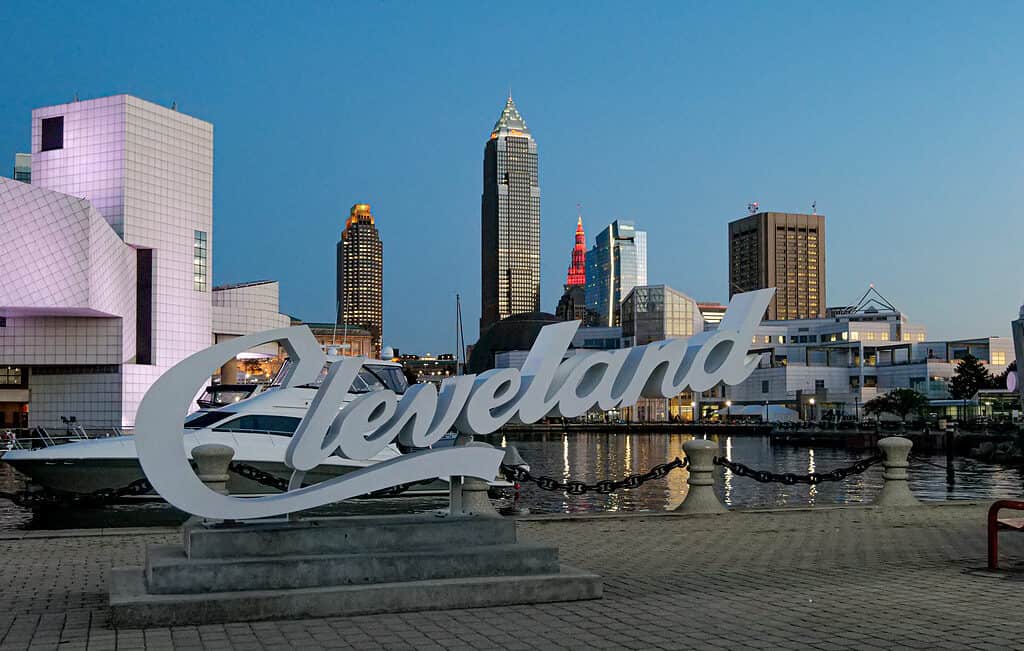Lakes are bodies of salt or freshwater that range from a few feet to over 5,000 feet deep. Some lakes were created millions of years ago, while others were built recently to irrigate drought-prone states.
Many animal species live in lakes, and people take advantage of their safer swimming or boating water compared to the choppy sea. There are many lakes across the United States of all shapes and sizes, even in states like Ohio that are chiefly landlocked.
Let’s discover the deepest lake in Cuyahoga County, Ohio, its history, and what lurks beneath the surface.

Where Is Cuyahoga County?
Cuyahoga County is in Ohio’s northeast. Its name comes from an anglicized spelling of cayagaga, which is Mohawk Indian for crooked river and refers to the Cuyahoga River that bisects Ohio.
A total of 1,264,817 people live there; the largest city is Cleveland. Cuyahoga County is Ohio’s second-largest county by area. The southeastern area is home to a large section of Cuyahoga Valley National Park. In Cuyahoga County’s north lies its deepest lake.

Cleveland is the largest city in Cuyahoga County and the biggest city situated on Lake Erie.
©iStock.com/Ralph Navarro
What’s the Deepest Lake in Cuyahoga County?
The deepest lake in Cuyahoga County is Lake Erie at 210 feet at its deepest point in the eastern basin. However, most of Lake Erie is around 62 feet deep. Cuyahoga County has 30 miles of the lake’s coast on its northern border. Across the lake is the Canadian border of Ontario.

Cuyahoga County contains 30 miles of Lake Erie’s coast, including Edgewater Park in Cleveland.
©Dee Browning/Shutterstock.com
Lake Erie Facts
Lake Erie is one of the Great Lakes, and although it’s the shallowest and smallest Great Lake by water volume, it is still the deepest lake in Cuyahoga County and all of Ohio. Its freshwater capacity is 116 cubic miles, and it’s actually the warmest Great Lake due to being the most shallow of the five.
In terms of size, Lake Erie’s surface area is 9,910 square miles. It’s the fourth-smallest Great Lake by surface area but still the fourth-largest in the whole of the United States. (The largest U.S. lake is the massive Lake Superior, with a whopping 31,700 square miles of surface area.) Although 30 miles of its coast lie in Cuyahoga County, Lake Erie has 871 miles of coastline in Michigan, Pennsylvania, and New York, too.
Lake Erie’s main outlet is the famous Niagara Falls. Niagara River connects Lake Ontario and Lake Erie via 36 miles of freshwater. Lake Erie’s water output helps hydroelectric power dams that provide power for both Canada and the United States.
Eleven million people source their drinking water from Lake Erie. It’s a massive tourism and fishery hotspot, not to mention an incredible ecosystem for wildlife.

Lake Erie’s main outlet is the famous Niagara Falls.
©YingHui Liu/Shutterstock.com
How Was Lake Erie Formed?
Like the other Great Lakes, Lake Erie was formed by rivers and glaciers 1 million to 12,600 years ago. Devonian era (400 million years ago) rocks form its basin. In the Devonian era, Lake Erie was a tropical reef. Glaciation has altered the Great Lakes’ sizes and shapes in the intervening years. The most recent alteration to Lake Erie was 4,000 years ago.
Today, it’s largely fed by water flow from the Detroit River, which makes up 80-90% of the flow into the lake.
Over time, many people have lived near its shores, drinking its freshwater and hunting fish or animals for food. Some of the first were the native Erie tribe, “the people of the panther,” and the Iroquois. European settlers found Lake Erie in 1669.
Is Lake Erie Clean Now?
Lake Erie is one of the Great Lakes, and it is the deepest lake in Cuyahoga County, but it’s had its share of problems over the years. In the 1960s and 1970s, Lake Erie was considered dying because there were so many toxic algal blooms and a very low number of sport fish there. The problem was the amount of phosphorus entering its waters, chiefly from wastewater plants eliminating laundry detergents, which led to the Great Lakes Water Quality Agreement.
Once the phosphorus intake was halved, Lake Erie came back to life. However, in 2003, algae bloom was again present. Algae blooms threaten human health, the ecosystem, and businesses, so it is a real problem. Today, the water is often safe enough to swim in. Its quality is checked regularly because runoff from sewage plants, cities, and farmland surpasses all the other lakes’ pollution. In its favor, Lake Erie has a turnover of water every 2.6 years, so problems can quickly be eliminated.
Where Is Lake Erie Located on a Map?
Lake Erie is situated in Canada and the United States. The lake’s northern shore is the Canadian province of Ontario, and U.S. states are on its other shores, with Michigan at its west, Ohio at its south, and Pennsylvania at its east. Major cities along the lake shores include Cleveland, OH; Buffalo, NY; Erie, PA; and Toledo, OH.
The lake’s main inlet is the Detroit River, with its primary natural outflow via the Niagara River. Its tributary rivers include Michigan’s Huron and Raisin; Ohio’s Cuyahoga, Grand, Maumee, Portage, and Sandusky; New York’s Cattaraugus Creek; and Ontario’s Grand River.
Lake Erie Compared to the Deepest Lake in the U.S. and the World
The deepest lake in Cuyahoga County is Lake Erie at 210 feet, but it’s a mere puddle compared to Crater Lake in Oregon. Crater Lake is the deepest lake in the U.S. at 1,943 feet deep. Despite its massive depth, it’s famous for its beautiful blue water and has no inlets. This is because it was formed by and is topped up by rain and snow melt.
Lake Erie ranks as the eleventh largest lake worldwide. It holds the title of being the southernmost and among the Great Lakes, as well as having the smallest volume. Consequently, it also exhibits the shortest average water residence time.
The deepest lake in the world (that we know of!) is the 5,387 feet deep Lake Baikal in southern Siberia, Russia! This lake is so huge it’s larger than all of the Great Lakes’ surface areas combined.
What to Do at Lake Erie
The deepest lake in Cuyahoga County, Ohio, offers everything you’d expect at a great tourist destination.
Beaches
With miles of shoreline, it’s easy to find a quiet spot to relax and forget the world. Enjoy the peace and look out for wildlife. Many visitors enjoy scouting for lighthouses with binoculars.
Swimming
Swimming in Lake Erie is possible if there are no algal blooms or contamination issues. Keep an eye on the flags and Ohio’s Department of Health website for up-to-date information. Although Lake Erie is generally safe for swimming, standing waves called seiches occur in the west bay. They are dangerous and catch the most experienced swimmers.
Water Sports
Paddleboarders enjoy the view stretching from Port Clinton, and lots of kayakers start at Put-in-Bay.
Fishing
Lake Erie is packed with fish and has a reputation as one of the best fishing spots in the U.S. for walleye, but there are masses of bass, trout, perch, and salmon in its waters too.
Keep a watch for Lake Erie’s legendary beast (or is it?) Bessie. Anglers report a fish of epic proportions in Lake Erie; many think it’s a monster sturgeon. In Lake Erie’s vast waters, the sturgeon can reach over 12 feet (3.7 meters) long! Bessie could be larger, but no one has caught it yet and found out for sure.
What’s in Lake Erie?
Other than a monster fish, Lake Erie’s waters contain over 2,000 shipwrecks. The oldest shipwreck in Lake Erie is The Lake Serpent, which sank in 1829 on a journey to Lake Erie Islands to collect limestone. The 47-foot schooner was lost, and its captain’s remains were washed up in nearby Lorain County. Other shipwrecks include freighters, steamships, fishing boats, and tugs, all waiting for divers to discover.
Animals at Lake Erie
Cuyahoga County’s deepest lake is home to a massive ecosystem because the lake water is joined by grasslands, wetlands, and forests, pretty much every habitat you can find in the United States.
Animals living in or near Lake Erie include gray wolves, moose, beaver, little brown bats, coyotes, mute swans, bald eagles, bobolink, snapping turtles, and the endangered Kirtland’s warbler.
Experts consider the most dangerous animal in Lake Erie the sea lamprey, which is an invasive creature that preys on sport fish like trout. Lampreys suck nutrients from the still-living fish, often causing fatal wounds.

Lampreys suck nutrients from the still-living fish, often causing fatal wounds.
©Gena Melendrez/Shutterstock.com
The photo featured at the top of this post is © iStock.com/sara_winter
Thank you for reading! Have some feedback for us? Contact the AZ Animals editorial team.






